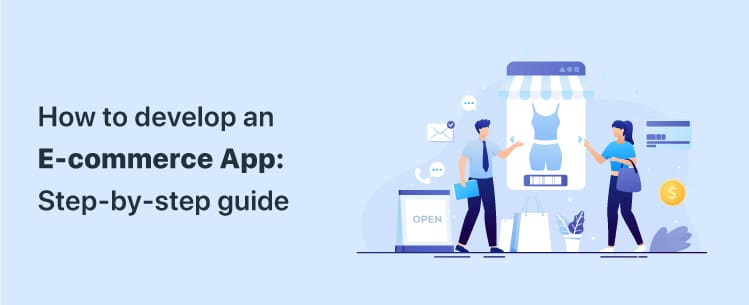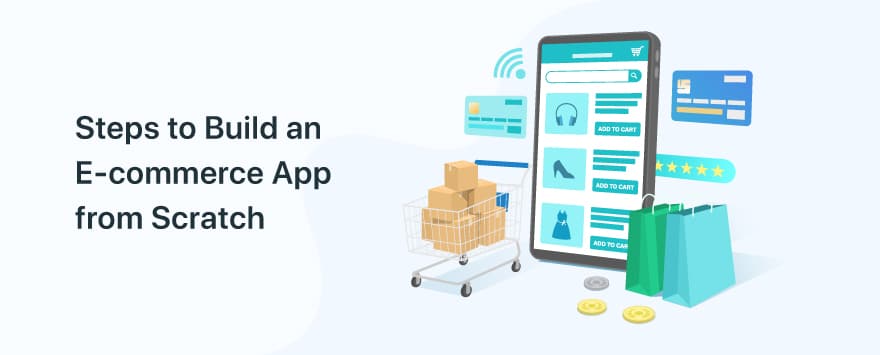
Quick Summary
E-commerce has reshaped how we shop and do business. With the ever-growing demand for online shopping, creating a seamless and feature-rich e-commerce app has never been more critical. Whether you’re an entrepreneur looking to enter the e-commerce market or a developer seeking to expand your skill set, this blog will take you through every step of building a successful e-commerce app from scratch.
Statistics
Since the early 2000s, the eCommerce market has been on a constant rise, with no sign of slowing down in the foreseeable future. Worldwide retail sales are expected to reach $8.14 by 2026 from $6.31 in 2023.
Entrepreneurs have been paying attention to this field for a long time now, as it has been expanding rapidly thanks to the widespread adoption of smartphones and the internet, the proliferation of omnichannel business models, and the development of novel payment options.
Let’s skip the discussion of the justifications for mobile app development for e-commerce and instead go into the nuts and bolts of the process.
Why build an e-commerce app?
78% of users globally prefer accessing a store through mobile apps, while 35% of US customers shop online using mobile phones. US consumers find it easier to compare prices on smartphones.
An estimated 82 billion hours are spent on shopping apps annually in the UK, which accounts for one-third of all shopping. Making your Store accessible on mobile devices may thus pay off handsomely in the long run.
Here are some of the reasons why your business needs an ECommerce Mobile App-
Higher Targeted Customers
Mobile internet buying is even more handy than regular online purchasing. Your customer base might expand at a rate comparable to your revenue increase. Your software can reach millions of people when it is included in a major app store like the Android/Google Play Store or the Apple iOS Software Store. You can reach billions of people if your app is available on the Apple and Google app stores.
Repeat Customers
Having an eCommerce app is a great way to elevate your brand presence. By downloading and displaying your app on your customers’ mobile screens, you can keep them engaged and interested in your products or services 24/7.
By offering a personalized experience, you can convert first-time buyers into loyal customers, increasing sales, customer loyalty, and long-term trust. By leveraging the convenience of mobile internet buying, you can expand your customer base and revenue growth. In short, eCommerce app development is a powerful strategy for strengthening your brand presence and achieving business success.
Convenient Shopping Experiences
A mobile e-commerce application can be a game-changer for your business. Customers prefer convenience while shopping online, and an eCommerce mobile app offers it very well. It simplifies the buying process, from product search to payment, making it more convenient.
Moreover, you can enhance customer engagement with real-time communication via push notifications. You can inform your customers about upcoming sales, new product releases, and other exciting news. In addition, you can suggest similar products that they might find interesting, fostering stronger relationships with your customers and encouraging them to return.

Customer Insights
Do you want to take your business to the next level? If so, it’s important to understand your customers and how to improve their shopping experience. E-commerce apps are a great way to do this!
Collecting valuable customer data lets you personalize marketing strategies and gain insights into what your customers want and like. This information can help you interact with customers and provide better customer service. An e-commerce mobile app lets you easily access information about customers’ geographic location, purchasing habits, interests, and more. Using this data, you can better understand your customers and improve their overall experience with your business.
Omni Channel Experience
Providing your customers with a seamless shopping experience is crucial for your business success. With a well-designed application, your customers can access your online store from any device and enjoy the same look and feel as your website.
This consistency makes it easier for them to navigate and find what they need without hassle. Everything in one place allows customers to easily reorder items or discover new ones without remembering which platform or device they used.
Competitive Advantage
A mobile app gives you a competitive edge by helping you adapt to your customer’s changing needs and preferences. By providing a seamless mobile shopping experience, you can set yourself apart from competitors and win over new customers who are constantly looking for convenient ways to shop.
Cost-effective Marketing
Mobile applications are a cost-effective marketing tool for businesses. They offer direct communication with customers for real-time engagement and interaction. By sending push notifications, you can inform customers about new products, exclusive deals, and special promotions without spending a fortune on advertising campaigns. This can help boost brand loyalty, enhance customer experience, and increase sales.

Steps to Build an E-commerce App from Scratch
Planning, designing, developing, and testing an e-commerce software from the start is no easy task. To help you build an e-commerce app from the ground up, here is a detailed guide:
Determine Business’s Objectives
Establishing these parameters is essential before beginning work on an ecommerce app’s design and development. Determine your end goal for the app, whether it’s more revenue, better client loyalty, or a wider market presence. Consider who you’re making the app for, what they’re like, and what they want to accomplish.
Select a Platform and Framework
Your e-commerce app’s success relies heavily on selecting a suitable platform and framework. To make apps that operate on both Android and iOS, you may want to use a cross-platform mobile development framework like React Native or Flutter. Consider the platform’s hosting, security, scalability, and capacity to work with your current infrastructure as you decide.
Plan the E-commerce Application
It might be challenging to design fully functional eCommerce software from scratch. The user experience, the brand, the functionality, and the integrations are just a few of the numerous considerations.Nevertheless, a well-designed and implemented eCommerce app can be within your reach by partnering with a reputable mobile app development company that brings the expertise of skilled professionals to the table.
When creating an eCommerce app, the first step is to consider who will use it. This will help direct the design process and target relevant users. The next step is to consider the people who will use the app and their interactions with it. The objective should be to design a user-friendly app that lets people quickly and easily discover the necessary information.
Consistency in the app’s design and aesthetics is crucial for effective branding. Maintaining consistency means always utilizing the same colors, typefaces, and logos. Visuals should be carefully selected to promote a favorable image of the company. It’s crucial to provide functions of interest and utility to the intended customers. For instance, features like a shopping cart and payment gateway integration would be crucial if you plan to sell things online. Finally, consider the external services your app will require while planning connectors.
Develop the Backend
There are a few crucial factors to consider while building the infrastructure for an ecommerce app’s backend. Ensure your server can manage the anticipated volume of users before releasing your program to the public. Second, you’ll need to create a database to house and access all of the information related to your program. Finally, you’ll need to manage all the requests and replies coming in and going out using some code you build.
There are several choices available for the underlying server infrastructure. Shared hosting can be all that’s needed for a few simple apps. However, dedicated servers or even a cloud-based solution may be required for programs that are particularly large or receive great traffic. Selecting between a relational database like MySQL or MariaDB and a non-relational database like MongoDB is an important first step in database design. Finally, there are many different programming languages to choose from when developing the app’s backend; pick one with which you are familiar and which can provide the features and capabilities you need.
Incorporate shipping and payment options
Your e-commerce app’s payment setup options are varied. You may use a commonplace service like PayPal or Stripe, or you can go with something more tailored to your needs, like Shopify Payments. Whatever you decide, you must ensure that your chosen payment gateway is compatible with your preferred delivery method.
Shipping connectors for common payment gateways may usually be found in the gateway’s Developer Centre or API documentation. One such integration is with UPS, which allows consumers to monitor the progress of their packages without ever leaving the PayPal page.
While utilizing Shopify Payments, you may choose from several shipping connections. Shipping connectors for Shopify Payments may be found in several third-party apps besides Shopify’s integration with UPS.
Regardless of your approach, ensuring compatibility between your payment gateway and shipping solution is crucial to providing a smooth transaction for your customers.
Launch and Test
After developing your e-commerce app, you should put it through its paces to ensure it is error-free. Your application can be scored in a few different ways:
- You may still test your app using a simulator or emulator if you don’t have a real device. The functionality and appearance of your app on a mobile device may be tested with the help of simulators and emulators.
- Install your app on a real device and use it for testing if you have one. This is the most reliable method for predicting how well your program will do in actual use.
- Use people willing to try out your software before it’s released to the public (known as “beta testers”). They can tell you about their problems and feelings about your app.
- It’s time to release the software once you’ve ensured it’s bug-free and thoroughly tested. You may accomplish this by making your app accessible for download on your site or submitting it to a third-party app store, such as the App Store or Google Play.
Monitor and Improve
After releasing your app, tracking use and user feedback is important to see where you can make changes. Consider implementing analytics software to monitor KPIs like user participation, customer loyalty, and revenue growth. Maintain regular app updates to keep up with user and market demands.
Developing e-commerce software from scratch requires extensive research, planning, design, coding, testing, and optimization. Use this as a guide to create a functional, user-friendly, and profitable e-commerce app.
How Much Does It Cost To Create An ECommerce App?
The cost of building an eCommerce app is a crucial concern for any entrepreneur. This quote is crucial for financial projections and cost plans.
However, the pricing quote also depends on many aspects of the project. From app features to third-party integrations and testing to maintenance, every step incurs its own cost.
Here are the factors that affect the cost of developing an e-commerce app.
App Features—The app features directly affect the cost. The higher the number and complexity of features, the higher the cost.
App Platform—Android, iOS, or both—this choice greatly impacts the app development cost. Building native apps will cost 2X, while cross-platform apps can be available on both platforms at half the cost.
Design—If the design is simple, the cost will be less. The complexity of designs that include animations and complex graphics raises the cost. UI matters significantly in attracting users to your business applications. Experienced designers will craft app solutions based on the latest design trends. Also, aligning the design with your branding is highly important.
Development—Hiring an experienced and reliable development agency will surely cost more, but it is worth it. Developing an application includes choosing the right technology stack, APIs, etc. Besides experience, the location of the development team also affects the cost.
In Western Europe, the usual pay for an App Designer can be between $50 and $100 per hour, while in the United States and Canada, it starts at $150. Prices range from $35 to $60, with the best deals in Eastern Europe.
Maintenance—Building an e-commerce app is an ongoing process. New additions and improvements are always being made. Maintaining an e-commerce application includes fixing bugs or security issues. Regular updates are a must to maintain higher speed and a better customer experience.
Based on these factors, developing eCommerce software may cost you $80,000, $150,000, or more. Estimating the starting price tag in advance takes time. Feel free to contact us about your proposed eCommerce app and the specific products you’d like to see pricing for. We’ll fill you in on all the specifics.
Essential Functions for Any Shopping App
Register & Login
Users must create an account and log in to purchase from your Online Store. Online shopping apps should make it simple for customers to create an account and begin shopping immediately.
Inventory Management
The availability of a product is an important factor for online shoppers. Thus, your e-commerce platform must have robust inventory management features. This reduces the likelihood of buyers being disappointed if the item they want is out of stock.
Customer Management
E-Commerce software enables you to manage your E-Commerce users, including consumers, shop managers, and administrators. This method is essential for running a successful company. In addition, the most sought-after feature in creating e-commerce apps is the provision of first-rate customer support and the personalization of services.
Search Bar
Customers often visit a website to do a certain type of transaction. A search bar makes it simple for users to locate the information they need. Customers needing clarification on a website’s lack of a search box will likely exit the page immediately. It’s best practice to have the menu bar at the top when designing an app.
Product Page
A good product page may produce more revenue than any other strategy. Include all the details—price, shipping info, sizing options, color palette, etc. Also, remember to include high-quality images, ideally in a gallery format.
Wish Lists
Customers of both B2B and B2C businesses find great value in wishlists. B2B customers like to make many purchases at once, and a wishlist speeds up the process of making subsequent purchases.
Order Processing
E-commerce platforms should facilitate the management and tracking of orders through order processing functionalities. This will ensure that your online business functions well and that purchases are processed fast.
Shipping
E-commerce platforms must provide shipping options so buyers can compare rates and estimate their delivery date before making a final decision. This lessens the prospect of shoppers becoming dissatisfied with their purchases due to excessive delivery fees.
One-Page Checkout
This feature allows customers to make their purchases swiftly and easily without navigating through many pages throughout the checkout process. People in haste sometimes need to remember essentials, such as their postal address. Thus, this feature might be quite useful.
Order Tracking
An integral part of any good e-commerce platform is the ability for consumers to view the current status of their orders at any time. This will reduce customer irritability and increase customer satisfaction with your company.
Conclusion
The future of retail is in e-commerce applications. If you have a customer-facing app, you can stay ahead of the competition in today’s market.
Building an e-commerce app from scratch is challenging, but the result can be incredibly rewarding. You can successfully navigate the development process with a well-defined plan of action and an experienced development partner.
ValueTree is a top mobile development company with over a decade of experience in the industry. We can create robust and successful e-commerce app solutions that meet the needs of your business and your customers. Contact us today for a free consultation.
